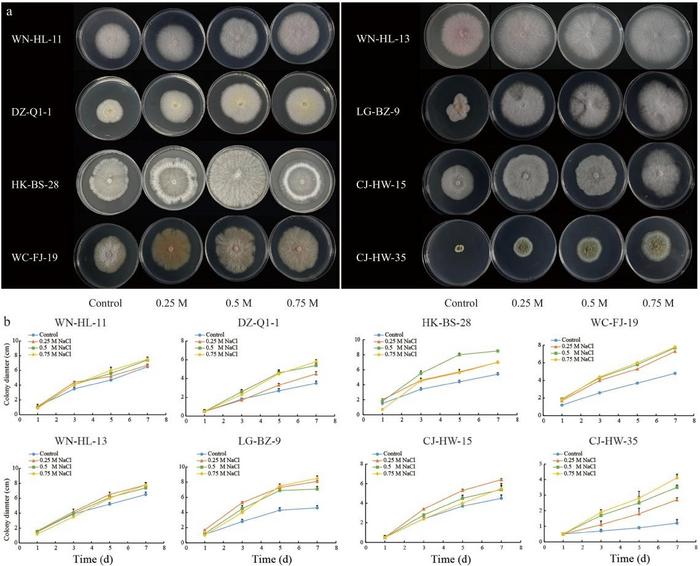Soil salinization stands as one of the most pressing environmental challenges confronting modern agriculture. Today, over three percent of the Earth’s terrestrial surface suffers from this phenomenon, leading to devastating impacts on crop productivity worldwide. The accumulation of salts in soil generates osmotic stress, ionic imbalance, and oxidative damage to plants, frequently resulting in yield losses exceeding fifty percent. Traditional soil reclamation techniques such as mechanical leaching or chemical amendments remain economically burdensome and environmentally unsustainable on a large scale. Against this backdrop, the role of microorganisms, particularly endophytic fungi inhabiting halophytic plants, has emerged as a beacon of hope in developing resilient, cost-effective agricultural strategies to counter saline stress.
Endophytic fungi (EF) refer to those microorganisms that reside asymptomatically within plant tissues, often forming mutualistic associations that enhance plant fitness. The unique ability of certain EF to thrive in saline environments and improve host plant tolerance has prompted an upsurge in research focused on their utilization as bioinoculants in agriculture. These fungi influence plant stress responses by modulating physiological and molecular pathways, including ion homeostasis, reactive oxygen species scavenging, and phytohormone regulation. Their symbiotic relationship supports plants navigating extreme habitats, making them prime candidates for integrated soil and crop management in saline-affected regions.
A cutting-edge study led by researchers Yanping Hu and Yang Zhou at Hainan University—published in the prestigious journal Tropical Plants on March 19, 2025—pioneers an in-depth exploration of endophytic fungi isolated from Sesuvium portulacastrum, a coastal halophytic species well adapted to saline soils surrounding Hainan Island. The investigation focused on isolating and characterizing these fungi to determine their potential in enhancing salt tolerance in maize, an essential global crop highly vulnerable to salinity stress.
Employing a meticulous tissue block technique, the research team successfully isolated 426 cultivable root endophytic fungi from 1,180 tissue blocks of S. portulacastrum. Subsequent molecular analysis utilizing the BLAST tool against the NCBI database enabled classification into 112 operational taxonomic units (OTUs), highlighting considerable biodiversity within the fungal community inhabiting halophytic roots. Diversity indices such as the Shannon-Wiener and Simpson’s index revealed significant variability across 20 sampling sites, with HK-BS and QH-GH regions exhibiting the highest diversity metrics respectively. Among genera identified, Fusarium was most predominant, accompanied by Pleosporales and Monosporascus, indicating a complex fungal assemblage adapted to saline environments.
To elucidate salt tolerance traits, the study incorporated an innovative plate screening method exposing EF isolates to varied sodium chloride concentrations on potato dextrose agar (PDA) plates. Remarkably, eight fungal strains demonstrated enhanced growth performance under 0.75 M NaCl conditions, exhibiting colony diameters 1.6 to 1.8 times larger than their non-saline controls. The standout strain, LG-BZ-9—classified as Fusarium incarnatum—captured attention for its superior salt tolerance and potential bioinoculant properties.
Building on these insights, LG-BZ-9 underwent rigorous evaluation to assess its effects on maize subjected to salt stress. Experimental treatments involved inoculating maize seedlings exposed to 250 mM NaCl with the fungi under controlled conditions. Quantitative analyses unveiled significant improvements in fresh biomass accumulation, plant height, and chlorophyll content in LG-BZ-9-treated plants compared to uninoculated saline controls. These physiological enhancements translated into robust growth, signaling effective mitigation of salt-induced growth inhibition by the EF.
At the mechanistic level, LG-BZ-9 influenced maize’s ion homeostasis by modulating the intracellular concentrations of potassium (K+) and sodium (Na+) ions. Treated plants exhibited elevated K+ levels alongside reduced Na+ accumulation, thereby enhancing the critical K+/Na+ ratio fundamental to cellular enzyme function and osmotic regulation. This ionic rebalancing reduces toxic sodium effects while maintaining essential potassium-dependent physiological processes, underscoring the fungi’s role in salt stress alleviation.
Crucially, the findings establish that endophytic fungi like F. incarnatum LG-BZ-9 function as biological regulators capable of fine-tuning ion transport and sequestration pathways within host plants. Their symbiotic interaction effectively fortifies maize defenses against osmotic and ionic disturbances typical of saline conditions, fostering greater resilience and sustained growth performance. Such microbial interventions represent a transformative approach in sustainable agriculture, circumventing dependence on chemical soil amendments and enhancing environmental compatibility.
The study’s implications extend beyond maize cultivation, promoting halophyte-associated endophytic fungi as a valuable resource for developing bioinoculants tailored to diverse crops and geographical regions affected by salinization. Harnessing native fungal biodiversity from saline ecosystems offers a repository of adaptive traits crucial for climate-smart agricultural innovations. This research not only contributes foundational scientific knowledge but also catalyzes a paradigm shift toward eco-friendly, cost-effective strategies combating global soil degradation.
Looking forward, scaling the application of these fungal inoculants necessitates comprehensive field trials across varied saline contexts to validate efficacy and stability under real-world agricultural systems. Integrative studies combining genomic, proteomic, and metabolomic profiling will further elucidate the molecular crosstalk mediating plant-fungi interactions under salt stress. Moreover, expanding isolation efforts to a broader array of halophytic hosts may uncover novel fungal partners with complementary or enhanced capabilities, enriching the bioinoculant portfolio available to farmers.
In conclusion, this breakthrough study by Hu, Zhou, and colleagues exemplifies the frontier of agricultural biotechnology, where harnessing halophyte-associated endophytic fungi offers promising avenues for mitigating salt stress and ensuring food security. By leveraging the symbiotic potential embedded within saline ecosystems, science advances toward reclaiming marginal lands, improving crop productivity, and promoting sustainable farming amid escalating environmental challenges. The integration of these microbial allies into mainstream agriculture heralds a new era where biology-driven solutions provide practical, scalable tools for confronting the pressing demands of a changing world.
Subject of Research: Not applicable
Article Title: Endophytic fungi isolated from the roots of the coastal halophyte Sesuvium portulacastrum around Hainan Island enhance salt tolerance in maize through regulating K+/Na+ homeostasis
News Publication Date: 19-Mar-2025
References:
DOI: 10.48130/tp-0025-0005
Image Credits: The authors
Keywords: Mathematics, Research methods




